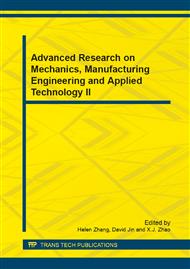p.309
p.313
p.317
p.321
p.326
p.331
p.335
p.339
p.343
Research on Biological Materials with Optimization of Spray Drying Walnut Antioxidant Polypeptide Using Response Surface Methodology
Abstract:
Response surface methodology (RSM) was employed to optimize the spray drying process for walnut polypeptide, which were hydrolyzed by papain and trypsin. Air inlet temperature, air outlet temperature and feed concentration as well as cross-interaction among these factors exhibited a significant effect on collection rate and DPPH scavenging activity of walnut polypeptide powder. Results showed that the optimal drying parameters were air inlet temperature of 172℃, air outlet temperature of 88℃ and feed concentration of 23 %. The observed collection rate and DPPH scavenging activity of polypeptide powder under the optimal conditions was up to 91.28 % and 76.33 %, respectively, which was consistent with the predicted result.
Info:
Periodical:
Pages:
326-330
Citation:
Online since:
April 2014
Authors:
Price:
Сopyright:
© 2014 Trans Tech Publications Ltd. All Rights Reserved
Share:
Citation:


